North Ridge, Lone Pine Peak
I feel like an idiot. The ends of my long underwear are rolled to my knees, my feet are shod in loosely-laced mountaineering boots, and I’m not wearing anything else. The height of fashion.
I imagine the people crowding the Whitney Portal when there’s no snow. The parking lots, the expansive campground, the private summer cabins on the hill. Right now as I stroll through in my underwear, it’s completely empty.
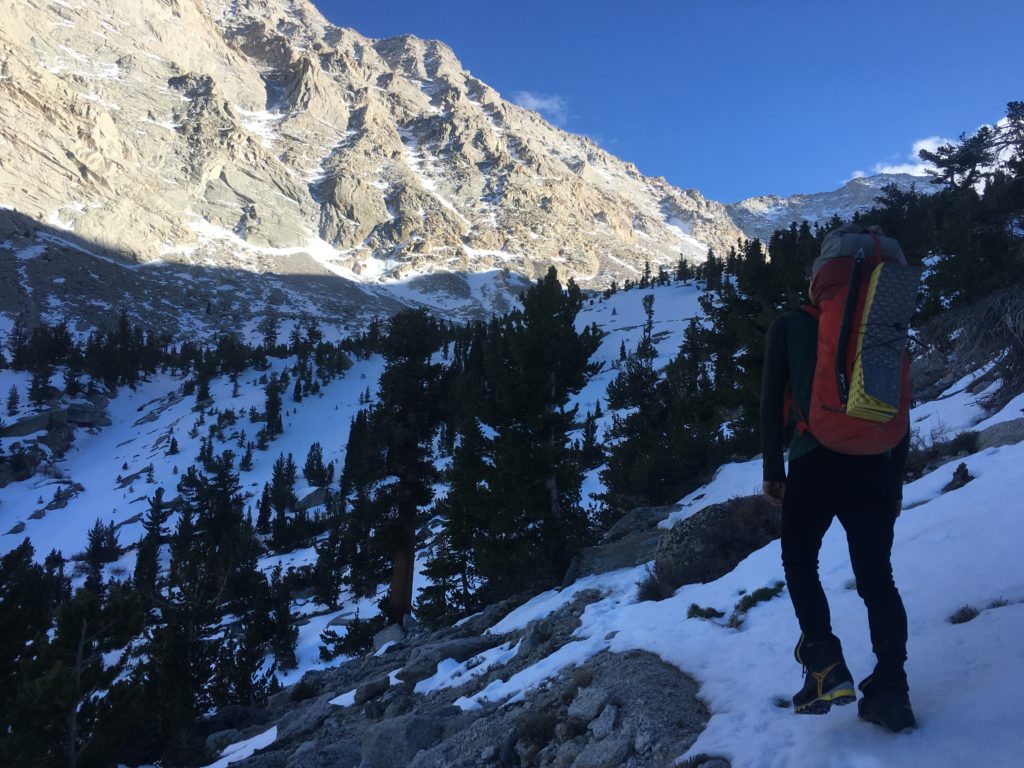
Marcus and I are headed for Lone Pine Peak. Often mistaken for Whitney because it’s more visible from the highway below, Lone Pine Peak creeps down from twelve thousand feet to the desert floor below with a series of long ridges. Our objective was the North Ridge.
In summer, the North Ridge is a long and easy alpine romp. We couldn’t find much information about winter ascents, but it seemed like a good option as most of the ridge is 3rd or 4th class with only a few pitches of 5.5 or less. Typical ascents of the route skip a long slog through rotten granite kitty litter from the desert floor by traversing over from 10k to the ridge proper. Not feeling as hardcore as the gentleman we met in the gear shop — “take it from the desert floor, man” — we decided this was a good idea, and camped before the snowfield traverse.
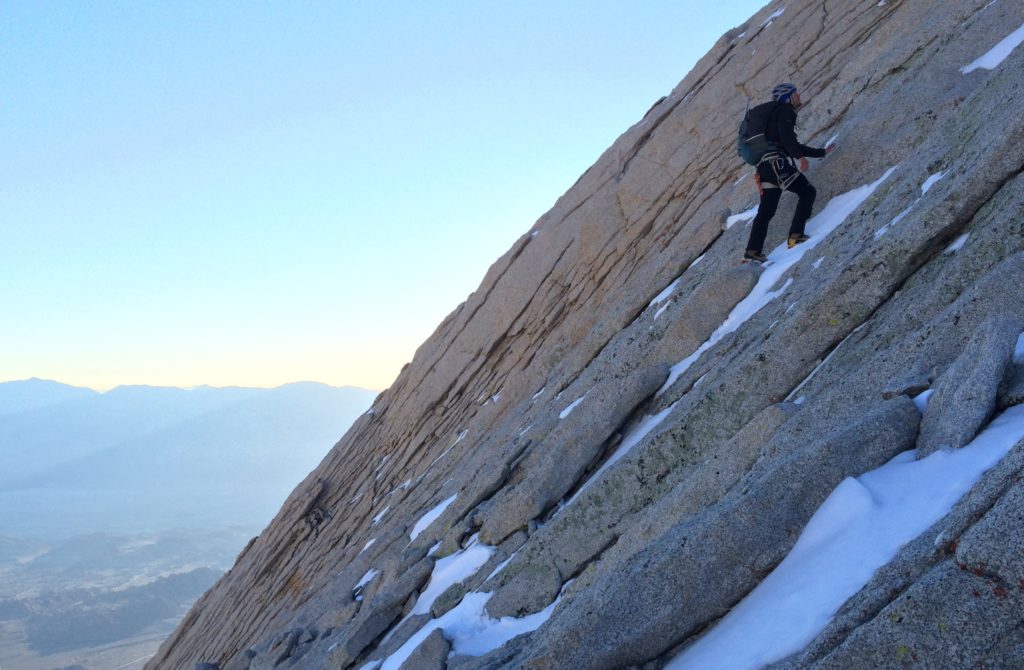
After speedily nailing the approach in the morning we were feeling pretty good about getting the whole route done before dark. The fourth class terrain was snowy but went quickly in boots. It wasn’t until we reached the first pitch of fifth-class climbing that we realized our mistake — no crampons. We reasoned that there wouldn’t be enough ice on the sun-baked ridge to warrant their weight. If there’s a bit of ice, we’ll climb around it in rock shoes, we thought.
“Dude, I’m really scared,” I hear Marcus’ warbly voice call down. He won the bid for the first roped pitch, a low angle crack. Which apparently is filled entirely with ice. We have no ice screws. Marcus is chopping tenuous steps with a 65cm piolet to make upward progress and has run out of gear options.
“Can you lower off of your ice axe?” I call up. Silence. He fiddles around for another five minutes; I wait patiently poised. “Take! Lower!” He comes down, a bit shaken but totally okay, and explains the predicament above. With no pro options and a downclimb too insecure to be worth the attempt, he did indeed sink his piolet into the ice filled crack and lower off of it. “I am so happy that thing didn’t pop, man.”
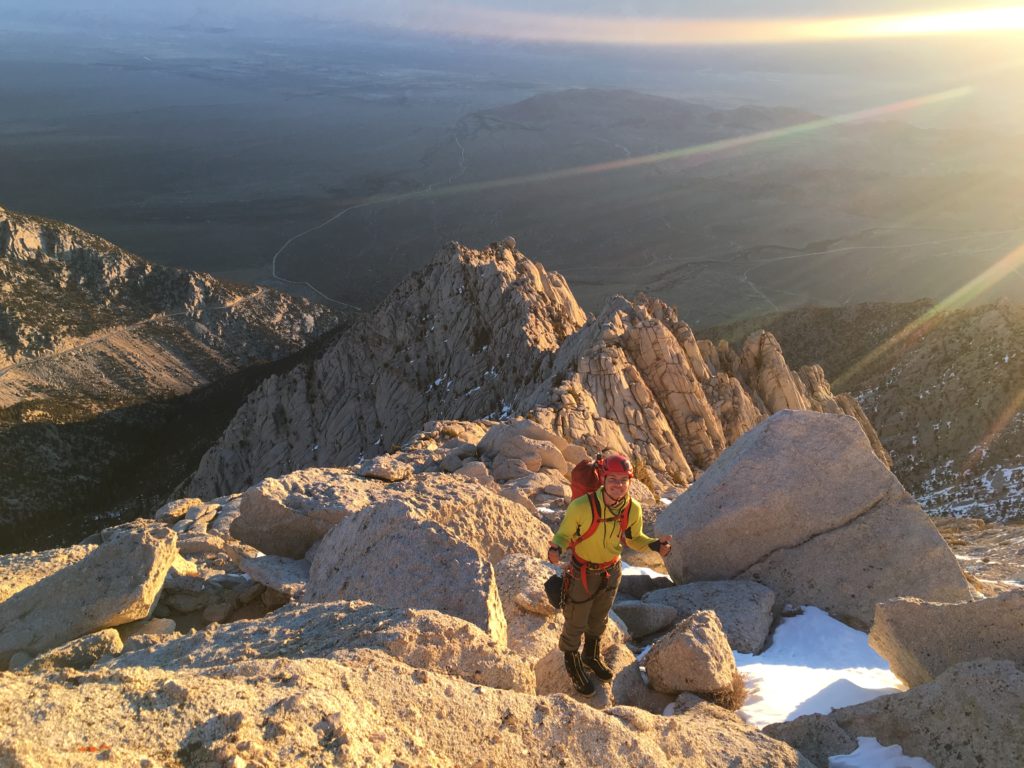
And after a solid ten minutes of rope-whipping, we were able to get the axe back — it popped out and came clanging down the granite and landed in the snow in front of us with a quiet plump. Our first (inadvertent) foray into retrievable rap anchors.
Feeling a bit dumb for not bringing crampons and ice tools, we had a good laugh about the absurdity of the situation and agreed the best thing to do would be to bail. All of the more difficult technical pitches of the climb were the same aspect and angle of this particular crack and we anticipated running into the same problem.
A big sigh of relief typically follows a justifiable reason to bail on a climb. This time was no exception — we sat on a flat sunny section of the ridge and had ourselves a glorious nap before heading back to the tent. We schemed for the next route the whole way down.
Winter Route, Lone Pine Peak
“I guess it’s time to start walking.” After carefully bridging a deep rut on a steep incline, the Subaru stalled in first gear, and my car-fears came true: no amount of clutch feathering would replace a low-range transmission. We descended our uphill progress in a semi-controlled backwards slide down the steep, rutted road to a pullout and traded wheels for boots.
A feeling of unfinished business persisted on Lone Pine Peak. We weren’t quite motivated enough to return immediately to the North Ridge, so we turned our eyes to the steep South Face on our topo map. The obvious choice was the Winter Route: three thousand feet of climbing took one through narrow gullies of steep snow connected by easy sections of rock, to a notch rappel and a final block of climbing through a headwall.
Driving through a desert to get to a snow climb is an interesting feeling. Trudging up a steep dirt road in mountain boots with enough darkness to conceal the alpine realm waiting above completed the strangeness. One of the landmarks on the approach is what is called the Stone House. In the ‘60s, a religious group laboriously hauled materials up the steep trail to build a house that was abandoned decades after the slow construction started. After a government plan to demolish the unfinished structure met resistance by locals, the building was allowed to exist as it is now — a dreamy concrete shell nestled into a granite overlook, the massive south face of Lone Pine Peak dominating the doors and windows.
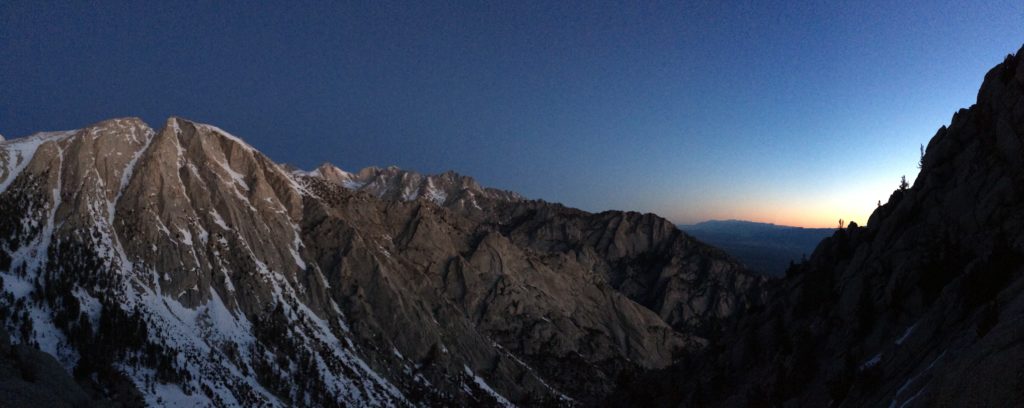
The magic of the sun rising through the empty window panes in the Stone House was enough to temporarily quell our urge for efficiency. We stood around, reading graffiti in quiet wonder until we remembered: climbing! Go! From the start, this climb felt more adventurous than the well-worn rock routes our prior destinations had provided. An intentionally vague route description was our main guide: snow gully, rock band, snow gully, rap the notch, climb the headwall. There was no approach trail and no trace of other humans. All was well.
A boulder-hopping wind through a steep wash deposited us as the base of the first snow gully. It was hot and the snow was soft and the crampons we so acutely lacked on the other side of the mountain were now heavy backpack ornaments. Wearing both rock shoes and mountain boots on one climb was a first for me, but we were happy to make the switch to sticky rubber for the block of simulclimbing we connected the two snow gullies with.
Barely-visible boot prints snaked up the long second gully, ghostly hints of a party on the route weeks before. We slogged in the gully up and up until choking into a pitch of steep mixed climbing that ended up being the crux of the route. I charged into it without recovering the rest of the rack from our last simul-block — something I quickly regretted as I stepped high above my last cam. Loose blocks and detached ice threatened the length of the stimulating pitch, but Marcus followed up with no issue and we made one rappel to gain the base of the headwall.
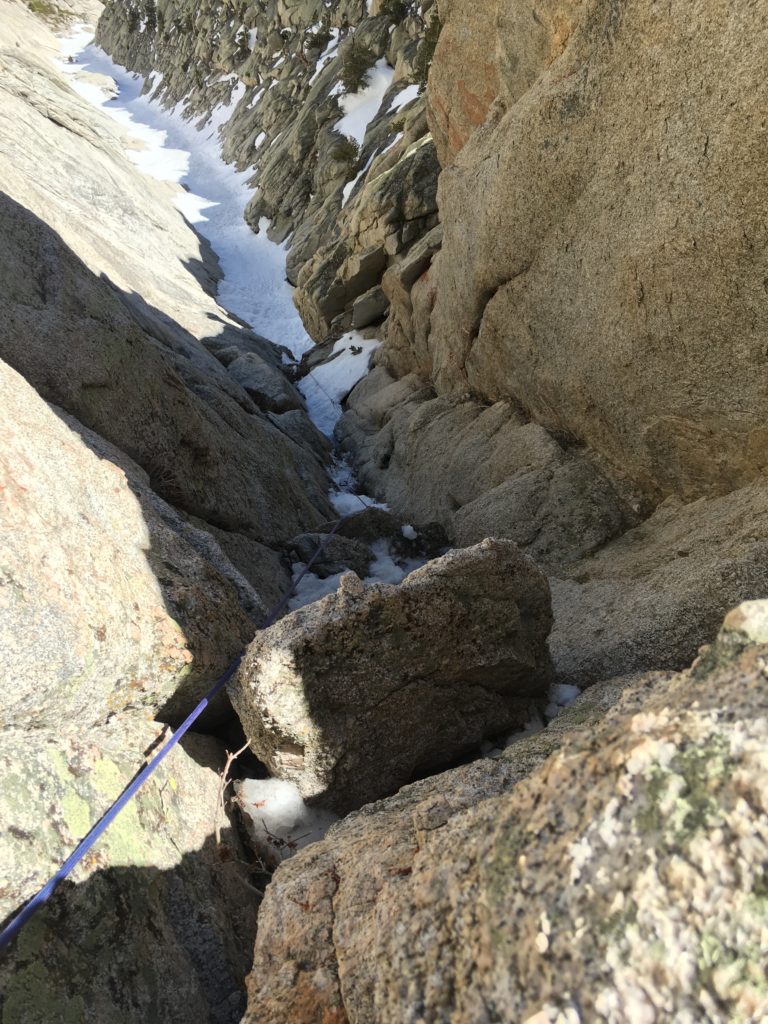
A few poorly protected pitches of 5.7 in rock shoes led us to not quite where we wanted to be: topping out on a small tower revealed another looming headwall in front of us. Our attempts to fall back on published information got us nowhere, and eventually the blind quest upwards began. After getting off of our false summit and traversing over a pitch, one more rope length led us to 4th class terrain that popped out on the summit plateau.
It was like topping out on the Moon — the adjective lunar never felt more apt. Granite gravel covered the flat and expansive plateau punctuated by small boulders and son patches. The already-set sun cast a blue glow over the bizarre landscape.
The descent was “non-trivial,” as one Mountain Project user promised. It started out better than it ended, with a couple thousand feet of surfing down steep gravel slopes. Which, when you get over your guilt about erosion, is great fun. Gravel surfing lead to a dicey down climb on steep snow that lead to a rappel that lead to a healthy dose of dense bushwhacking and down climbing.
The climax was a wet river crossing and one last burly uphill to gain the trail — back to the desert floor. We rolled back to the car eighteen hours after leaving, beat as ever but happy to finally get to the top of something.
Beckey Route, El Segundo Buttress
For the second time in two days I weave my car around the big plywood “Road Closed” sign that sits at the entrance of Whitney Portal road. The last time we drove by the sign it was eschew in the center of the road; today it has been pushed almost all the way into the ditch. Signs of the incoming spring and summer crowds, I think as we motor up the steep road. In a few thousand feet and a wicked switchback or two the road transports you from the arid desert floor into an alpine wonderland, granite buttresses and snowy peaks in every direction.

As a “rest day” activity we’ve decided to climb a moderate route on one of those same buttresses. The Beckey Route cruises up the side of El Segundo Buttress in four or five pitches of 5.9. Cold wind bites through my wind shirt at the base of the climb. Another poor choice in layering — fooled by the great big blue sky yet again.
I shiver in sunshine at the first belay while Marcus stretches the rope on the first pitch. When it’s my turn to take over I have a brief moment of regret at the crux move of the climb, mumbling something profane to Marcus about the nature of a rest day, but I manage to gather my wits enough to pull through unscathed.
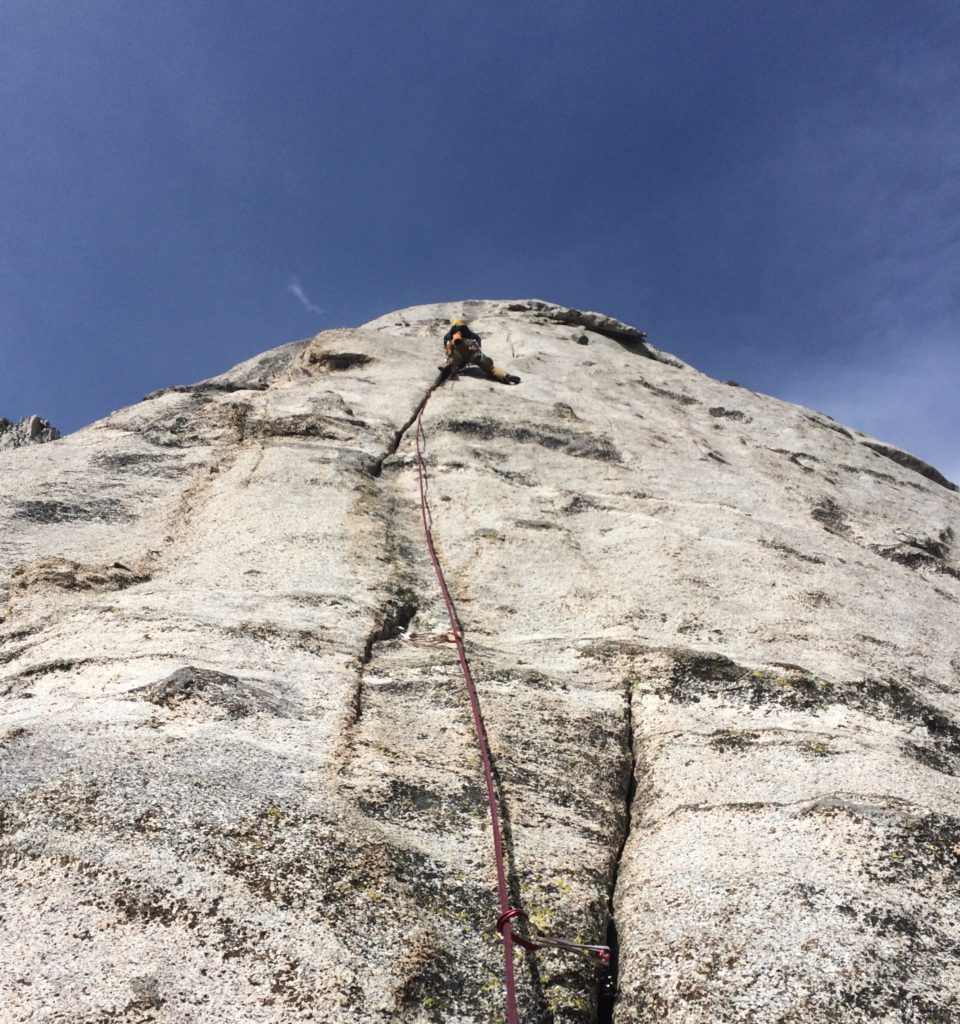
The top half of the climb is runout slab climbing — by far my least favorite thing to do in rock shoes — but thankfully Marcus got most of it in his block. The slab pitches definitely didn’t feel as easy as they should’ve and I realized it was probably pretty valuable training in an area I don’t have much confidence.
The top of the buttress held many secret patches of fine granite sand that overlook the spectacular Whitney Portal area, and again I realize how cool it is that only by climbing vertical faces would one find places like this. We breathe a sigh of relief when we nail the descent, and walk back to the car talking about how what was now an activity for a lazy afternoon would have been a serious undertaking for us as climbers as little as a year ago.